
No matter how planned or controlled, even a balcony container garden gets volunteer plants. These mushrooms are neon yellow.

東京を散歩中に、タヌキさんが足湯で休んでいます。日本の多くの場所のように、この公共の温泉にも数え切れないルールがあります。
At the foot bath, volunteers remind tanuki that, like most places in Japan, there are countless rules to follow here. Can a wild animal find happiness in the world’s largest city? Please find out tomorrow when tanuki visits Shibaura House to discuss Making Friends.
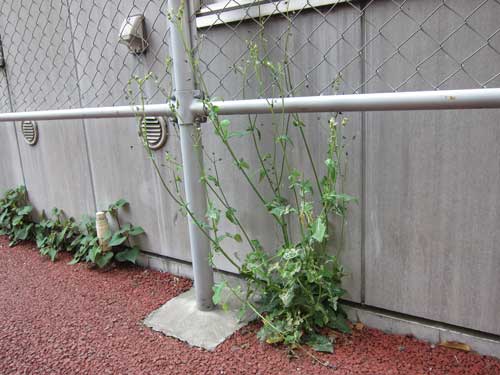
野草が見えて、夏はこれからだ。
Rainy season propels city weeds, and signals the start of our jungle-like summer.
Dandelion and dokudami, Shibuya. Related: see previous post about dokudami weed, and reader comments about edible versions in Vietnam.
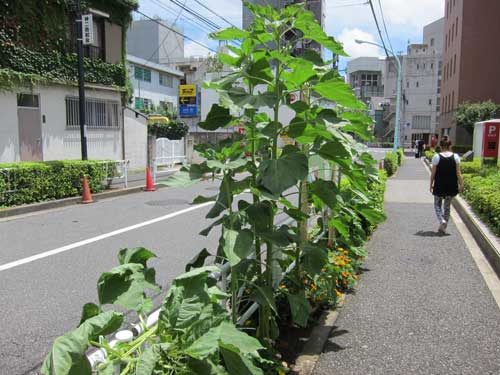
I love the small strips of green space between the sidewalk and the street. Generally, orderly bushes like azaleas are maintained by the local government. But there is always also a mix of volunteers plants and volunteer gardeners. In the scorching heat of July, these sunflowers are well over two meters tall. A week after taking this photo, I saw that the flowers had opened.
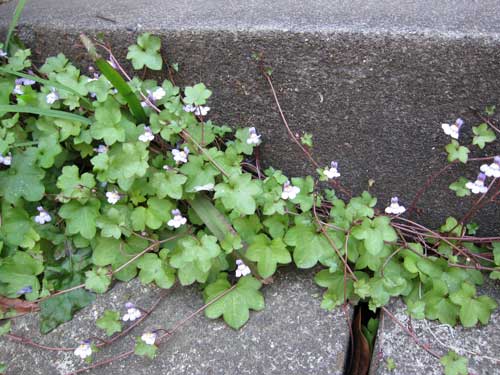
I have been noticing this weed with beautiful purple and white flowers all over Tokyo. It must be very hardy since it grows in the cracks of sidewalks and walls. Volunteer plants play an important role in urban nature, and show nature’s resilience despite our over-built environment.

I take care of my relatives ceramic studio garden. Last year’s 5bai midori “satoyama unit,” installed during a fall typhoon, is coming back with lots of new growth. This photo shows off the yellow flowers “yamabuki”, a vigorous Japanese shrub. Sometimes you see white flowers, or multi-petalled yellow ones.

Shiho ceramic studio‘s back yard is a small l-shape raised beds. Much of it is shaded by persimmon and plum trees and the neighbors’ homes. The garden includes a volunteer shurro palm tree (しゅろ, 棕櫚) and a Japanese herb called sanshou (サンショウ) that traveled from the neighboring store’s bicycle parking lot.
A lot of what I planted at the end of last year has come back, including hydrangea, lilies of the valley, hostas, rosemary, jasmine, and a lantern flower vine that almost fully covers the chain link fence. And the giant cymbidium orchid has been blooming through April. It’s great to hear that the ceramic teachers and students are enjoying the garden.
I think the eight bags of compost helped a lot in improving the soil and make this shade garden thrive.

One plant that didn’t survive the Tokyo winter is a plant commonly called “purple princess” in San Francisco. To fill the gap left by the plant and my hope for it growing large fast and covering the cinder block wall. I brought over a kanamemochi shrub: a quick growing and very popular Tokyo shrub with distinctive red, new spring leaves. I also planted a yuzu lemon tree and a white single petal yamabuki.


This plant in the foreground arrived on its own to my balcony container garden, and now it is flowering. The flowers look like peas, and the plant is growing vigorously with a nice cascading shape. Does anyone know the name of this plant?
In gardening, the unplanned is often the most intriguing. I wonder if the seed came in the wind, in the soil of another purchased plant, or by bird droppings. Even a small artificial ecosystem can take on a life of its own.
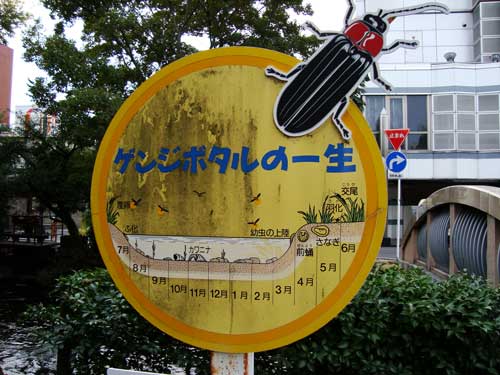
During an October visit to Okayama, a friend stumbled upon an amazing firefly habitat in Nishigawa park, a small canal with a lovely walking path cutting through the center of the city. Although now hatching below water, as the sign above shows, it was amazing to see how a city creats an urban habitat for fireflies. And it reminds me of Professor Suzuki Makoto’s firefly project in Shinagawa, Tokyo.

The firefly habitat occupies one long block of the Nishigawa park, which has different walkways, seating areas and plant arrangements on each block. For fireflies, there is a small slow-flowing, side canal where the fireflies hatch on the opposite side of the wood bridge from the main canal. A huge wall of vegetation provides nocturnal darkness and protection.

I am curious how long the park has been around, and what it is like during summer firefly season.
More on Nishigawa park after the jump.
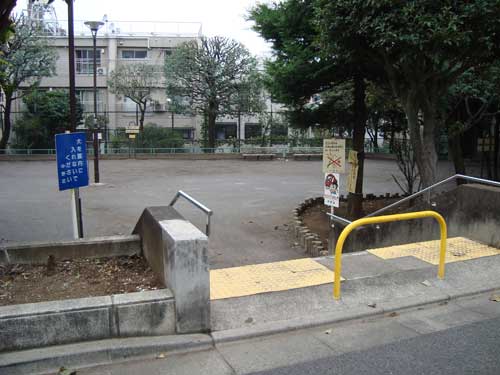
I am struck by how poorly maintained and under-used many of the residential neighborhood parks are. This one, close to where I live, is large, has many mature trees facing the street, and has almost no usage. To call it uninviting and unloved would be an understatement.
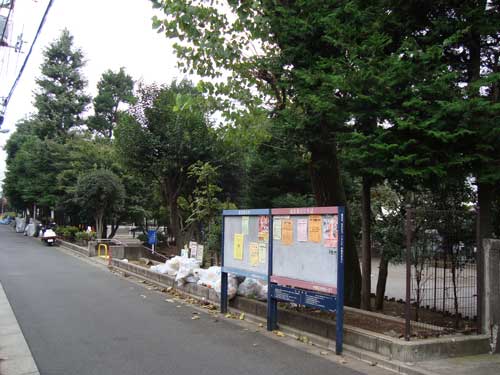
The street side is almost promising. There is a long row of mature trees and a community bulletin board. Next to the bulletin board, and also on the far end of the park, are designated areas to leave your trash. Unfortunately, there is no receptacle for the bagged garbage, so crows and cats pick through the bags and the contents start to disperse.
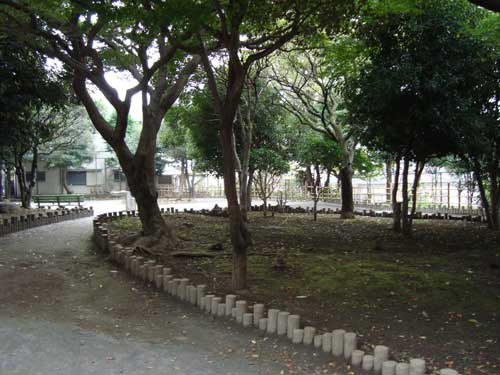
The entrance to the park reveals vast areas of gravel, unplanted beds, and few amenities or attractions. The size of the park only underscores the waste of so much public space going unused. Given how avidly neighbors tend to their tiny gardens and occupy small strips of public space, why are local governments unable to harness this human resource for beautifying and maintaining public space?
I can imagine many other uses for the park: community vegetable gardens, flower contests, rice field, bee hives, food stand, children’s play area, public art-making space. Given limits to local government budgets, maybe there would be a way to attract corporate sponsors and neighborhood volunteers. If more people were attracted to enter the park, I am sure it would be cleaner and more inviting.
After the jump is a photo inventory of the current park assets, mostly aging structures with a surprising amount of trash. During my visit I noticed a small garden crew and two people on a bench.
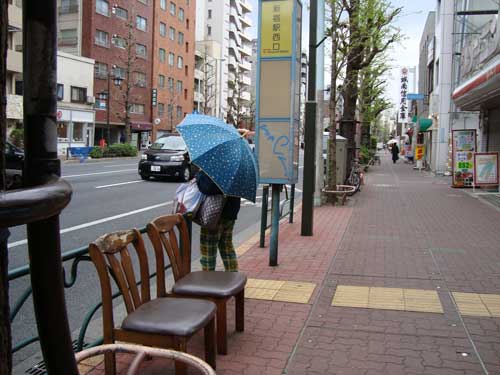
At many Tokyo bus stops, one can see old seats that have been anonymously contributed to the city scape. Sometimes you see old office chairs that swivel, or recycled dining room chairs. Some weather the rain better than others.
Certainly these volunteer seats provide more function than beauty to the street. A city-funded program would be more consistent and attractive. Still, the care that someone has taken to provide a public amenity where none existed is remarkable.
Like public greening, volunteer seats at bus stops blur the line between public and private space, and between municipal and volunteer street creation. It shows how city residents cultivate their environment, provide for their neighbors, and make small improvements.